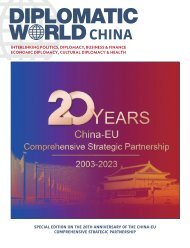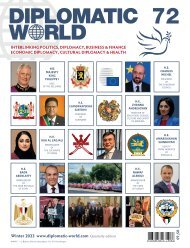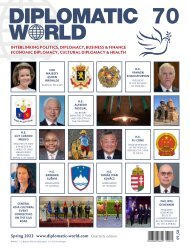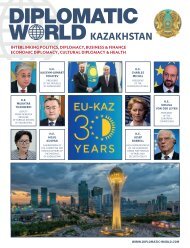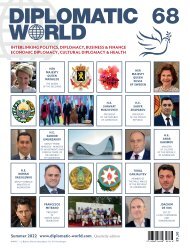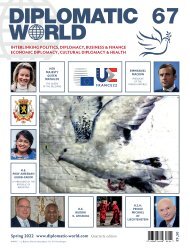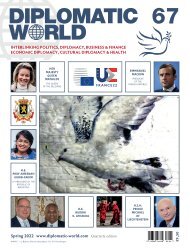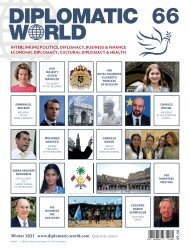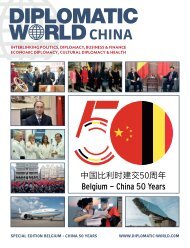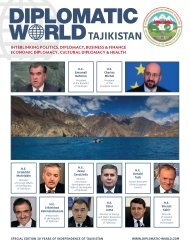Diplomatic World_69
You also want an ePaper? Increase the reach of your titles
YUMPU automatically turns print PDFs into web optimized ePapers that Google loves.
PORZELLAN MANUFAKTUR<br />
NYMPHENBURG<br />
A KNACK FOR DESIGN<br />
Even today, the traditional company from Munich, founded in<br />
1747, is regarded as an international authority on contemporary<br />
design.<br />
sieve - “even finer than nylon stockings”, says Gottwald. After<br />
that, the flawless raw mass rests for up to two years in the<br />
so-called Mauk cellar in the basement.<br />
It seems like a scene from another world: with calm gestures,<br />
experienced hands carefully pull the edges of a plate higher<br />
as it rotates on a wooden turntable towards its becoming. It is<br />
early afternoon, daylight illuminates the historic rooms of the<br />
Porzellan Manufaktur Nymphenburg.<br />
“Time is an important factor in the manufactory”, explains Sandra<br />
Gottwald. “Even when the kiln goes up, it is always a surprise.<br />
You have to constantly rethink and develop, the climate of the<br />
day also has to fit, that cannot always be determined. The material<br />
is special and idiosyncratic, it requires serenity in handling.”<br />
It is only a few hundred metres to the famous castle of the<br />
same name with its long canal. Today, Josef Knipfer has already<br />
shaped around 30 blanks, carefully and with feeling. Even though<br />
each plate will later have a base thickness of 4.8 mm when it<br />
is lined up on the shelf to dry – no two pieces are exactly alike,<br />
each one is unique. “Turning and drying are followed by firing in<br />
the kiln, first at 950 degrees during the glow firing, then again at<br />
1,380 degrees. Around 14 days of manual work go into such a<br />
plate”, says Knipfer, pressing a stamp with the blind mark into<br />
the still soft bottom of the plate and adding a hand-carved “J”<br />
for Josef. The ceramic tableware maker has been working here<br />
since 1976. He was one of the last to learn his trade here.<br />
FOCUS ON QUALITY<br />
Since the founding of the manufactory in 1747, the steps of<br />
porcelain making have not changed significantly. Since then, the<br />
focus has been on handwork as quality, for 275 years already –<br />
as if there were no 3D printers, no computer design, no Artificial<br />
Intelligence, no mass-produced goods from China.<br />
To this day, the fragile and delicate figurines, tableware series<br />
and design objects for which the manufactory is internationally<br />
renowned are still produced here at the Nymphenburger Schlossrondell.<br />
“One third of our turnover comes from services, one<br />
third from art editions and one third from special orders”, says<br />
Sandra Gottwald, who has been the company’s press officer for<br />
six years.<br />
Kaolin, quartz and feldspar are the three main ingredients for the<br />
white gold. What else goes into it remains a secret. Once a week,<br />
the mass is mixed and stirred for hours, then passed through a<br />
JUST LIKE IN THE OLD DAYS<br />
Just like in the old days, the workshops produce the porcelain<br />
mass themselves, using the power of the water from the nearby<br />
castle stream to drive the turning wheels, for example. Everything<br />
that appears to be round, i.e. plates, vases and bowls, is moulded<br />
as a solid mass on the wheel; everything that has corners or<br />
needs to be shaped into a figure has to be liquefied into “slip”,<br />
cast and sometimes painstakingly assembled. The moulds for<br />
casting are created in the model room. For the “Lightscape”<br />
series, for example, designed by Ruth Gurvich in 2009, white<br />
bisque porcelain on the outside, glazed on the inside. Here, the<br />
porcelain looks like stretched paper, with the edges hinted at<br />
here and there. The series was actually designed in paper, and<br />
the designs radiate that lightness.<br />
QUICK-CHANGE ARTIST<br />
Porcelain – a quick-change artist? Yes. For those who know<br />
how to exploit its materiality. There are 700 animal figures in the<br />
archive alone, we learn. Mouse “Karl”, for example, a modern<br />
contemporary for the home, designed by Wilhelm Neuhäuser.<br />
The shades are mixed in the colour laboratory, where there are<br />
300 shades of green alone. “The final firing changes the applied<br />
shade. This has to be correctly estimated through years of experience”,<br />
Gottwald explains.<br />
Things get really contemplative in the painting room on the first<br />
floor, a bright hall with tables lined up next to each other, flanked<br />
by long shelves of future gems. “It takes about a year to mix<br />
a colour properly,” says Eileen Knibbe, who can call herself a<br />
porcelain painter after her 3.5-year apprenticeship. She mixes<br />
pigments, turpentine, clove oil or 24-carat gold, for example, to<br />
apply a decorative gold decoration to a plate that mimics the<br />
shape of the material – with a brush made from the feathery hair<br />
of Siberian squirrels.<br />
LINK TO ART<br />
A few tables away, a colleague is painting a “Blue Panther”,<br />
earthen symbol for the Bavarian Television Award. The “Corine”,<br />
trophy of the Bavarian Book Trade, also literally gains colour<br />
here. Originally a figure from the Commedia dell’Arte, the statue<br />
is a reminder of the first great porcelain artist who helped the<br />
manufactory to early fame: Franz Anton Bustelli (1723-1763)<br />
created around 150 figures as a Rococo figurist and sculptor,<br />
16 of which are from the Commedia dell’Arte. Bustelli thus established<br />
the link to art that still exists today. He was followed by<br />
Dominikus Auliczek, who created around 100 figures, and then,<br />
196 197





